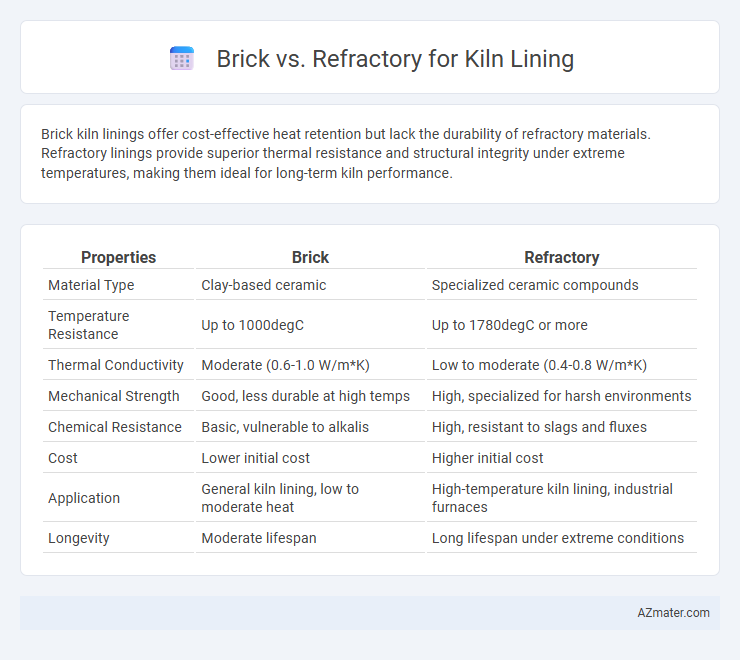Brick kiln linings offer cost-effective heat retention but lack the durability of refractory materials. Refractory linings provide superior thermal resistance and structural integrity under extreme temperatures, making them ideal for long-term kiln performance.
Table of Comparison
| Properties | Brick | Refractory |
|---|---|---|
| Material Type | Clay-based ceramic | Specialized ceramic compounds |
| Temperature Resistance | Up to 1000degC | Up to 1780degC or more |
| Thermal Conductivity | Moderate (0.6-1.0 W/m*K) | Low to moderate (0.4-0.8 W/m*K) |
| Mechanical Strength | Good, less durable at high temps | High, specialized for harsh environments |
| Chemical Resistance | Basic, vulnerable to alkalis | High, resistant to slags and fluxes |
| Cost | Lower initial cost | Higher initial cost |
| Application | General kiln lining, low to moderate heat | High-temperature kiln lining, industrial furnaces |
| Longevity | Moderate lifespan | Long lifespan under extreme conditions |
Introduction: The Importance of Kiln Lining Choice
Kiln lining significantly impacts thermal efficiency, durability, and operational safety in high-temperature industrial processes. Refractory linings, composed of specialized ceramic materials, offer superior heat resistance and longevity compared to standard brick linings. Selecting the appropriate lining material ensures optimal energy consumption and minimizes maintenance costs in continuous kiln operations.
Understanding Kiln Operating Conditions
Kiln lining materials must withstand high temperatures, thermal cycling, and chemical exposure, with refractory bricks offering superior resistance due to their dense, heat-retentive composition designed for extreme kiln operating conditions. Proper selection between standard bricks and specialized refractory bricks hinges on understanding peak kiln temperatures, atmosphere (oxidizing or reducing), and mechanical stress levels to ensure durability and energy efficiency. Optimizing kiln performance demands refractory bricks engineered to maintain structural integrity under rapid temperature fluctuations common in industrial firing and metal processing applications.
Properties of Bricks Used in Kiln Linings
Bricks used in kiln linings, such as fireclay and alumina bricks, exhibit high thermal resistance and durability crucial for withstanding extreme temperatures up to 1,700degC. Their low thermal conductivity minimizes heat loss, enhancing kiln efficiency, while resistance to chemical attack from fluxes and slags ensures structural integrity over prolonged use. The high compressive strength and thermal shock resistance of these bricks make them ideal for lining rotary and tunnel kilns where mechanical stress and rapid temperature fluctuations occur frequently.
Key Characteristics of Refractory Materials
Refractory materials used in kiln lining exhibit high thermal resistance, mechanical strength, and chemical stability, essential for withstanding extreme temperatures and corrosive environments. Unlike standard bricks, refractories such as fireclay, silica, and alumina bricks have superior insulating properties and resistance to thermal shock, which prolong kiln lifespan and efficiency. These materials possess low thermal conductivity and enhanced durability, making them critical for maintaining kiln integrity during high-temperature operations.
Thermal Performance Comparison: Brick vs Refractory
Fire bricks offer reliable thermal insulation with moderate heat retention, typically sustaining temperatures up to 1,200degC, making them suitable for general kiln lining. Refractory materials, such as castable refractories or insulating fire bricks, provide superior thermal performance by withstanding higher temperatures above 1,600degC and delivering enhanced heat resistance and lower thermal conductivity. The choice between fire brick and refractory linings impacts kiln efficiency, energy consumption, and lifespan due to their distinct thermal capacities and durability under extreme thermal cycling.
Installation and Maintenance Considerations
Kiln lining installation with firebrick requires precise alignment and careful mortar application to ensure thermal stability and reduce wear, while refractory castables offer faster placement and can conform to complex shapes with minimal joints. Maintenance for firebrick linings involves periodic inspection for cracks and replacement of damaged bricks to prevent heat loss and structural failure, whereas refractory linings typically benefit from easier patch repairs and lower thermal spalling rates. Considering kiln operating temperatures, cycling frequency, and mechanical stress informs the choice between durable firebrick and versatile refractory solutions for optimized kiln performance.
Cost Analysis: Initial and Long-Term Investment
Refractory lining for kilns typically demands a higher initial investment due to specialized materials and installation techniques but offers superior thermal resistance and durability, reducing maintenance frequency and overall downtime costs. Brick linings, often less expensive upfront, may require more frequent repairs or replacements, increasing long-term operational expenses. Evaluating total cost of ownership reveals refractory linings as more cost-effective for high-temperature, continuous-use kilns, while brick may suit lower-intensity applications with tighter budgets.
Durability and Lifespan Factors
Refractory lining offers superior durability for kiln applications due to its high resistance to thermal shock, chemical corrosion, and mechanical wear compared to traditional brick lining. The lifespan of refractory materials often exceeds that of standard bricks by withstanding extreme temperatures up to 1800degC and reducing maintenance frequency. Factors influencing these longevity advantages include refractory composition, kiln operating temperature, and exposure to aggressive atmospheres.
Environmental Impact and Sustainability
Refractory materials used for kiln lining offer superior thermal efficiency and longer lifespan compared to traditional bricks, reducing energy consumption and environmental footprint. Bricks, while more readily available and lower cost, often require more frequent replacement, leading to increased resource extraction and waste generation. Selecting high-quality refractory linings enhances sustainability by minimizing emissions and promoting energy conservation in industrial processes.
Conclusion: Selecting the Optimal Kiln Lining
Selecting the optimal kiln lining depends on operational temperature, chemical exposure, and mechanical stress, with refractory bricks offering superior heat resistance and durability for extreme conditions. Brick linings provide cost-effective solutions for moderate temperatures but may lack the longevity and thermal stability of high-quality refractory materials. Prioritizing precise thermal conductivity and chemical compatibility ensures enhanced kiln performance and extended service life.

Infographic: Brick vs Refractory for Kiln lining
 azmater.com
azmater.com